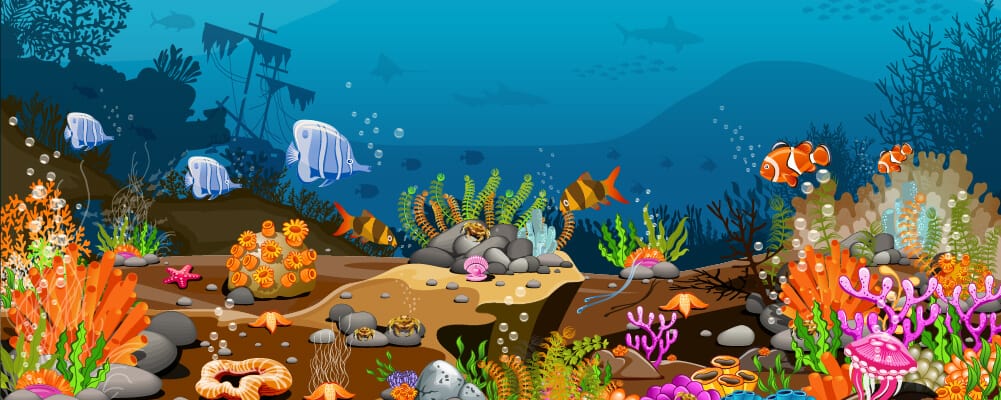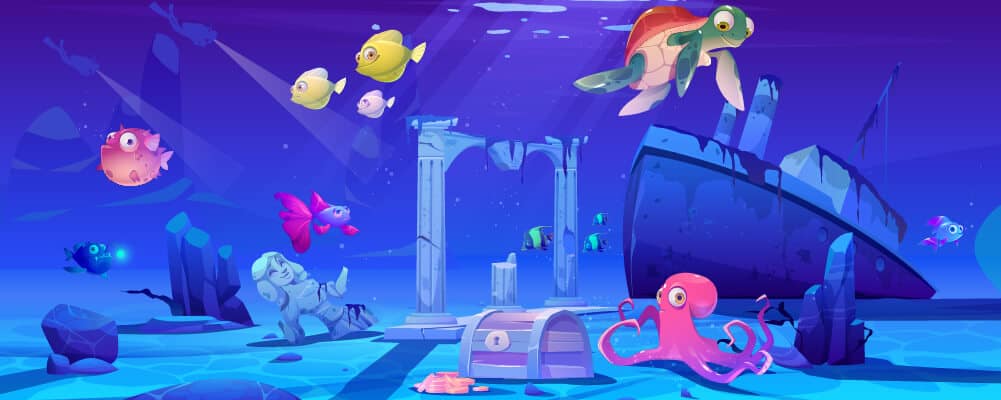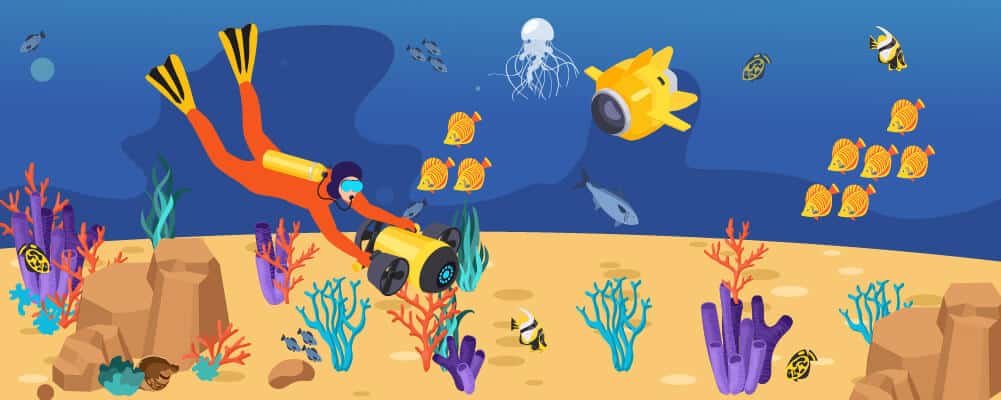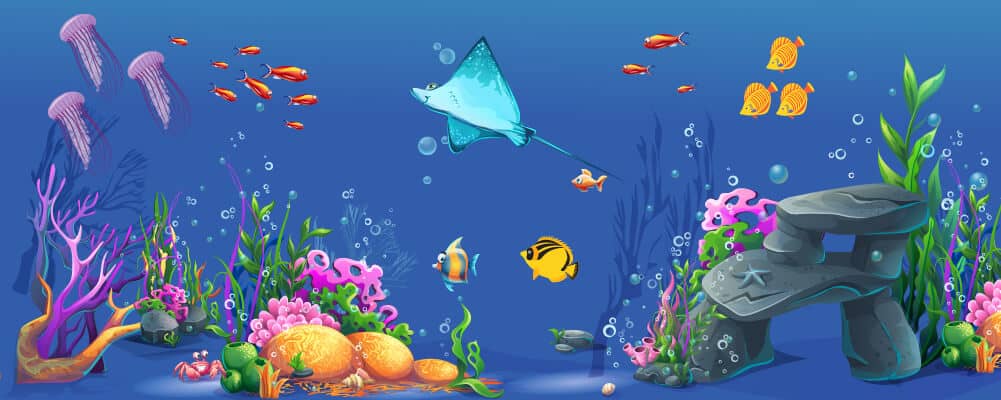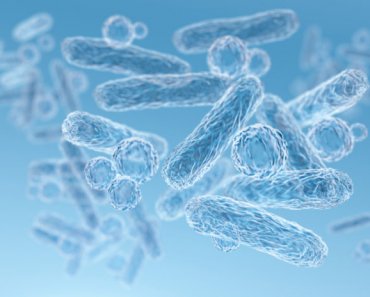Introduction
It’s part of human nature to be drawn to the unknown and unexplored, so it’s no wonder that so many of us are fascinated and intrigued by the ocean. The color blue brings a feeling of calm, tranquility, quiet, and reflectivity. It’s no wonder, considering how much of the earth’s surface is dominated by turquoise and deep blues. It seems part of human nature to be drawn to water, or things that are blue. Likewise, it gives our senses a rest and allows us to recharge.
Health benefits of being near the ocean, or even swimming in the water, include magnesium-rich water being great for relieving stress. It is also great for healing wounds, arthritis, eczema. Ancient Greeks relied on the healing properties of the ocean and understood the benefits to the human body. Swimming in the sea activates the body’s parasympathetic nervous system, which aids rest and repair and releasing dopamine and serotonin. There are negative ions in the sea air, which is why simply being near the ocean can make you feel good. Negative ions accelerate the body’s oxygen absorption and balance serotonin levels. The powers of the ocean seem untapped, and a beach vacation can do wonders for your relaxation levels, immune system, resistance to stress, and energy levels.
The beauty of the ocean is aided by the role of the media. The film industry has made plenty of viewers aware of the dangers of the ocean, as well as how breathtaking it can be. From the size of creatures to the sheer scale that they can be, films have only tapped into the potential of sea exploration. Not to mention feeding off the enormous uncertainty that exists when considering how vast and unexplored the ocean is. Some of the creatures from the deepest explored areas certainly look like something from a sci-fi movie. Fear of the unknown is strong when it comes to the ocean, and you can never feel one hundred percent safe.
The role that the ocean plays in climate change is not one to be overlooked. The ocean absorbs around a third of human-produced carbon dioxide and is becoming more polluted. Marine life, which remains largely undiscovered, is suffering, and unidentified species are becoming extinct. Human activity is fast-moving and wasteful, but the ocean is the biggest victim. Earth’s greatest wonder should be protected, and we need to act now to stop polluting it.
While films often depict colorful characters or fearful fish who are predators, the reality is that most of the ocean houses species somewhere in between. So many fish and marine mammals are overlooked simply because of their sheer quantity. This article is to celebrate the unremarkable and exercise a little appreciation for the unknown and the deep, unexplored ocean.
What Is The Ocean?
Put simply, the ocean is the largest saltwater body on the planet, covering 70% of the Earth’s surfaces. Because of that, it’s no wonder that there is so much about the ocean which we do not know yet. Containing 97% of the earth’s water, the ocean is so vast and unexplored that it has been compared to outer space. The silence and intense pressures are not dissimilar. Not to mention the difficulties that come with exploring both areas. The uncharted territory of space and the ocean force us to push the boundaries of modern technology and explore the beauty that comes with an element of fear of the unknown.
The ocean has such an enormous area of coverage that it is divided into four sections: Pacific, Atlantic, Indian, and the Arctic Ocean.
Pacific
This is the largest and deepest of the four oceanic divisions, 165.2 million square km. The Pacific is the only ocean that is bounded by subduction zones. Fishing plays a valuable role in the economy of the pacific, with shallow shoreline waters creating conditions for herring, salmon, sardines, snapper, and swordfish.
Impacts of human activities include:
- Overfishing– the fishing market is huge and, in spite of protection measures put in place to sustain fish populations, there has been a great deal of damage to fish species and ecosystems. More needs to be done to rebuild numbers and, once more, encourage biodiversity.
- Nuclear waste– several nuclear weapons were lost in the Pacific Ocean in 1946-1958. Following this, dumping radioactive water from Fukushima was approved thirty years later by the Japanese cabinet. More is estimated to be in the figures, contributing to pollution and unsafe nuclear levels in drinking water.
- Great pacific garbage patch– consisting mostly of microplastics, there is a patch of garbage floating between Hawaii and Japan. This is rapidly accumulating and currently double the size of Texas, massively contributing to damaged marine ecosystems.
- Impact of shipping– despite being the most energy-efficient method, ships contribute to the rising air, oil, and water pollution levels globally. Not to mention greenhouse gases, which are increasingly harmful to the environment. Panning across the Pacific Ocean and aiming to satisfy our growing needs as consumers, shipping is extremely harmful to the environment and marine life.
Atlantic
The second-largest ocean is the Atlantic, covering approximately 20% of the earth’s surface. An essential use of the Atlantic Ocean is major transatlantic transportation and communication. There are useful stores of natural resources, abundant sedimentary rocks of continental shelves. In spite of many protection treaties in place to protect the waters and life within it, marine debris and pollution are a growing problem within the Atlantic Ocean.
Indian
Contributing 19.8% of the earth’s water, the Indian Ocean is the third-largest ocean. It is the warmest of the oceans, with human activities inducing greenhouse warming. A benefit of which is that phytoplankton and tropical water species are able to boom. Russian, Japanese, and South Korean fleets exploit the Indian Ocean for tuna and shrimp.
Arctic Ocean
Living up to the name, the Arctic Ocean is the coldest of the world’s oceans and is the northernmost of them all. Although usually covered in sea ice during the winter, the arctic ice reached a new record minimum in 2012. The rate of melting is accelerating each year, with marine and land species native to the Arctic struggling for survival. Walruses and whale numbers are declining rapidly and more needs to be done to protect species.
Facts About The Ocean
Here are some interesting facts that you might not have known about the ocean and the role it plays in our lives, as well as some of the natural wonders that can be found deep within.
- Over 80% has never been mapped, seen, or explored by humans, hence why it’s referred to as vast and wide
- The majority of life on earth is aquatic; fish, plants, algae, and other sea organisms outnumber humans massively
- The ocean plays a huge role in regulating the earth’s climate, absorbing heat in the summer and releasing it during winter. Without the ocean, the earth would be too cold for human life. So, really we owe our lives to the ocean.
- Less than 5% of the planet’s oceans have been discovered
- The seafloor is not flat – the ocean floor is covered in sediment which comes from the last ice age. Mile-deep and wide craters form the bottom of the ocean with creates trenches, grooves, and ridges. It’s easy to imagine the bottom of the ocean as a smooth sandy desert, but it’s actually very uneven and thanks to human activity, contains debris and shipwrecks dating back centuries
- Fishers catch more than 90 million tons of seafood each year – growing. Populations create increasing demand for food. Overfishing causes the majority of the ocean’s environmental issues, and more needs to be done to create sustainable food sources and enable fish populations to replenish.
- The ocean is vastly useful for human life, it is a natural resource that has been relied on for centuries for food, transportation, and exploration. Fishing is a common source of livelihood for many across the globe and remains a tradition in marine cultures. Tidal energy is an effective source of sustainable energy which can provide yet another source of livelihood for us.
- The biggest ocean waves are actually beneath its surface – these are called internal waves and occur between two fluids of different densities. They can travel for thousands of miles and so grow to enormous sizes, some even reaching around 650 ft high.
- Hot streams – like on land, volcanoes are also present under the sea. Hydrothermal vents are complex structures formed of molten sediment that over time build up around a vent, resulting in a tall column that shoots out mainly grained sulfide minerals. They are instrumental in regulating the ocean’s complex chemistry and there are many biomes that rely heavily on the heat and minerals they produce.
- Underwater caves – Sedimentary deposits have created millions of complex cave networks that would make anything we have seen on the surface underwhelming. Human exploration has only touched the surface of how deep and complex some of these networks are. These networks hold many secrets and insights to possible unidentified species, but could also offer insight into the evolutionary history of our planet. Accessing these areas remains a struggle, with narrow passages, endless darkness, and crushing pressure, we are yet to reveal all it has to teach us. It’s no wonder people draw parallels between the depths of the ocean and outer space, both are dangerous and incredibly difficult to access.
- The air we breathe – Most people think of trees when it comes to producing the oxygen we breathe, but the oceans account for around 50-80% of oxygen production. This oxygen is produced by phytoplankton, kelp, and algae plankton through the process of photosynthesis, which converts carbon dioxide to breathable oxygen.
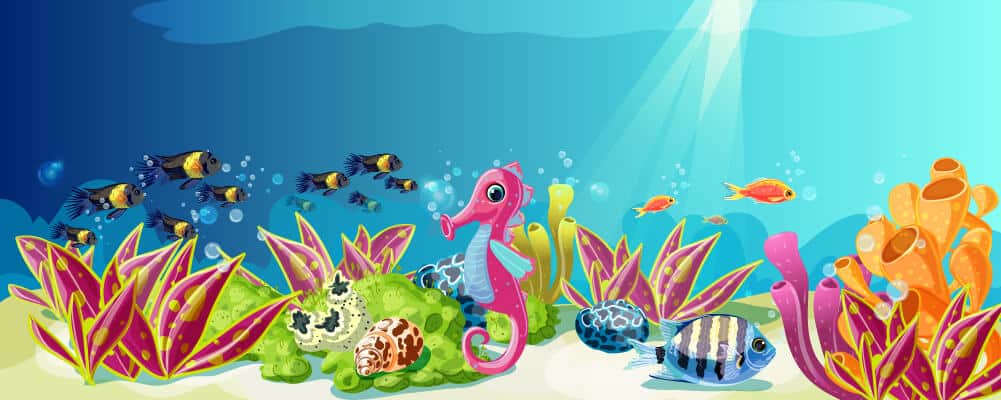
Now, let’s talk about the many species and plants that make up marine life. From coral to jellyfish, bioluminescence to seagrass. The ocean is a hub of life that thrives when left to its own devices. Varying in color, shape, and size, the variety that exists underwater is endless and fascinating.
- 20,000 species live in the ocean, not including those which have yet to be discovered. Fish certainly outnumber humans
- Marine gardens – shallow waters around the shores of the world’s oceans form underwater gardens. Seagrass thrives in this environment to the extent that it can become an underwater meadow. Speckled corals, tropical fish, and other unique plants thrive in these shallow waters because they are typically warmer and clear.
- Bioluminescence – species living in extreme environments adapt to form unusual features which make them suited to their habitat. An example of this is when fish that are typically found in deeper levels possess glowing lures to attract mates, respond to attacks, or even draw in prey. With the vastness of the ocean and the amount which remains undiscovered, bioluminescence could be the most common form of communication on the planet.
- Ocean fishes come in all different sizes, shapes, and colors. While some give off the appearance of a tough armor-style outer shell like the seahorse, others from deep seas look like they don’t have bones at all! The blobfish is a great example, as it looks like a ball of slime when removed from the depths of the ocean. Let’s not forget how a jellyfish doesn’t have a brain, but still has the power to take a life if aggravated. The stingray is also remarkable for similar properties. Their flat bodies take on the appearance of a sandy ocean floor, while their tails have high voltage deathly properties.
- The Atlantic cod is a protected species that can live for 25 years. The cod is very widely consumed by humans, and numbers have still not fully recovered from stocks collapsing in 1990. Cod spend most of their time close to the ocean floor, but can be seen in higher levels feeding on invertebrates and smaller fish. This species is considered highly vulnerable to extinction.
- Sea turtles and reptiles – turtle populations are declining, with more and more eggs being eaten before hatching or young not making it from hatch to water. There is a global ban on trading turtle parts, and they remain protected species. Polluting the world’s oceans and destruction to their feeding and nesting sites are main contributors to turtle mortality and them being classified as endangered. Speaking of creatures with tough shells, more and more reptiles are being kept as pets and their numbers remain intact in their native habitat.
- Marine mammals occupy a lot of the ocean population; whales, dolphins, and porpoises are able to hold their breath for impressive amounts of time while diving for food in the depths.
- Thousands of different plants live in the ocean – seaweed, red algae, and phytoplankton are some of the many species contributing to the great biodiversity we see in the ocean. Plants provide crucial shelter and food to marine species avoiding prey. There are three types of plants in the ocean; sunli, twilight, and midnight. These categories stem from the amount of sunlight that each need for their survival and growth.
- Plants play a vital role in oxygenating the ocean – whether they float on the surface or are rooted to the ocean floor, plants in the ocean produce oxygen as a byproduct of photosynthesis. Carbon dioxide and sunlight are converted into sugars, which fish and other organisms can use for survival. Kelp grows in colder waters and uses small flotation bulbs to stay afloat, it is the largest marine plant in the world and can grow up to 250 m long. Red algae is a uniquely colored species found in warmer waters and contains a pigment that absorbs blue light and reflects red. It is rich in vitamins and nutrients, just like kelp. Other common marine plant species include seagrass and sargassum.
The Future Of The Ocean
Hopefully, by now you’ve learned a little about the role that the ocean plays in human life, the food we eat and importing goods. However, the role of human activity on the ocean is proving to be detrimental. Climate change is getting worse and is showing no sign of slowing down unless serious action is taken and the climate crisis is recognized.
- Plastic – if we continue in the same way, by 2050 there will be more plastic in the ocean than fish. In modern society, everything is plastic wrapped and non-recyclable. Microplastics pollute the oceans and are so small that fish species ingest these. The wasteful society that we live in has reached a point that is irreversible and causing long-term damage to our ecosystems.
- Climate change – greenhouse gases are on the rise and the ice caps are melting. The role that this plays on the oceans can be detrimental. For many, people will lose their livelihoods, freak weather patterns are among other catastrophic outcomes following climate change. Extreme drought, tsunamis, storms, and tornadoes contribute to dramatic patterns of change.
- Pollution – garbage, industrial waste, and nuclear waste play such a large role in fish populations. As well as overfishing, oil spills are responsible for declining numbers and quality of biodiversity.
- Co2– carbon dioxide is heating up the planet. As the main contributor to global warming, more and more species are suffering from the increasing temperatures. The ocean absorbs carbon dioxide and without it, survival would be impossible. Earth’s oceans are more essential than trees and more attention needs to be made and they cannot stand up for themselves.
- Desalination plants are emerging in areas experiencing water shortages, more and more people are trying to make use of the ocean. However, the desalination process is expensive and uses up a lot of our natural resources. Research needs to be done to find a more sustainable and efficient way to filter seawater and eliminate the salt and microplastics in order to create drinking water.
- Around 80% of marine pollution is derived from land-based activities – as seen with the garbage island in the Pacific, industries need to engage in more environmentally friendly procedures.
- Solid waste is expected to double within 15 years if nothing is done. Factories are among the largest polluters, and big brands like The Ocean Cleanup are pressuring companies to be more conscious of their waste and reuse their waste products when possible.
- The majority is unexplored but also unprotected – unprotected areas are prone to issues such as overfishing, an issue that doesn’t just harm the population of fish being pulled from the ocean, but also caused an imbalance in the ecosystem. Furthermore, other fish that rely upon that species for food will also reduce in population, as their food chain has been disrupted and the supply just is not there for them. So keeping marine ecosystems balanced is crucial.
- What are we doing about it – The harm we have been causing the world’s oceans is now an ongoing international conversation, with systems being developed to combat and attempt to rectify the problems. The main issues facing the oceans are overfishing, and the effect this is having on already fragile ecosystems. The other is the amount of waste that we are allowing into the oceans. This polluting waste can take hundreds of years to decompose, with ocean creatures getting caught in rubbish, consuming the rubbish, or the rubbish poisoning the waters that they call home.
- Systems in place – System 001, Seabin v5, and Mr. Trash Wheel are among some of the systems that are being trialed around the world, system 001 for example is a 62-mile-long barrier that is currently taking out 80,000 tonnes of plastics, microplastics, and ghost nets that are currently floating around between Hawaii and California. There are also organizations in place, like 4Ocean that strive to take plastics out of our oceans, making new products out of some of these plastics, like bracelets.
- A long way to go – The future seems uncertain for our oceans, with growing populations around the world causing the demand for food to rise, our oceans are under more and more pressure. This combined with the pollution being put into our seas is causing a growing issue. With the world governing bodies only really starting to wake up to the problems this will cause in the future recently, the technologies and systems are not yet in place to counteract these issues, but there is hope. With many initiatives being set up and new technologies being put to use all the time, only time will tell if it is enough to save what is left of our oceans.
- What can we do to help – in order to make this growing problem easier we all need to come together and begin making changes, even small changes to the way we conduct ourselves in day-to-day life can help. Shop more wisely: when doing your shopping, instead of picking items that are sealed in plastic packaging, find alternatives that use more easily recyclable materials, or loose items. There is a growing movement of zero-waste stores showing up everywhere, promoting the reuse of containers, and selling products that have been sustainably sourced and grown.
Saving water and energy: Limiting the amount of water we use by having quick showers instead of baths, and using water sparingly will reduce surface run-off and reduce wastewater entering our oceans. Making sure to turn the lights off, and any other technologies you are not using is another easy way to do your bit for the environment and therefore our oceans.
Summary
To conclude, the ocean is a vast, beautiful body of water covering most of the earth’s surface. So many interesting species offer a wealth of biodiversity and although it remains largely unexplored, estimated depths are significant. The plants and animals that inhabit the ocean vary greatly, from glowing in the dark to tranquil sea turtles that make death-defying journeys the moment they hatch. The healing properties of the ocean have powers to uplift spirits and protect them from illnesses. However, these properties remain largely unexplored. Ancient civilizations treated the ocean with respect and the relationship between them seemed to prosper. When it comes down to it, things should be kept simple. We should take less to allow for growth, and in return, the ocean will continue to heal us and provide calm in a busy world.
Money makes the world go round and while we appreciate that the economy is in need of fossil fuel industries such as oil and natural resources including gold deposits, the ocean is also in need of help. We cannot continue in the way we are going on because along with the fast declining fish species, sea levels are climbing at an alarming rate. This means that climate change is already having an impact and destructive erosion, wetland flooding and agricultural soil contamination are more prevalent. There is only so far that money alone will get us, and it’s time to make a big change to more environmentally friendly ways in order for modern life to continue. The destructive ways of capitalist society need to end because more and more people are realizing that we cannot demand what we want and get it instantly. More people are taking a step back to appreciate the work that goes into something, even something as simple as a cup of coffee. Everything takes time to get, and in order to be sustainable, we cannot also appease the need for instant results. So much work goes into a service and simple changed to make life more simple yet environmentally friendly, are on the horizon.
Habitats are disappearing, and species numbers are declining. Although major companies are being pressured to do more, little is being done to reinforce populations and prevent something similar from happening again. The Blue Marine Foundation aims to tackle overfishing and develop protected areas to encourage population growth among marine species. Charities like this focus on areas that will need the most impact at any time. This is a great move for marine conservation and allows us to feel optimistic about more work being done. Hopefully, the future will see a rise in charities such as The Blue Marine Foundation.
Protecting the oceans is a good thing to do for species that live in them, but also for us as well. We, as a species, rely so heavily on what the ocean offers us, and we are at the mercy of it. If change isn’t made, rising sea levels will cause freak weather patterns that will affect our infrastructure and livelihoods. In order to protect ourselves and ensure a safe future with prosperous ecosystems and biodiversity, change needs to happen. The government needs to recognize that big companies are responsible for the majority of waste polluting the oceans.
Hopefully, by now, you’ve gained a new respect for the ocean and our natural resources. Maybe next time you go to the beach, try taking a minute to take in the natural beauty and feel thankful for the ocean. The vital effect on all life on earth is often overlooked. If you’re feeling overwhelmed and unsure of what to do, try writing to local governments and encourage them to make more conscious decisions about their energy sources. You could even research more sustainable swaps with your electric supplier. Of course, water waste is something that needs to be tackled. This is why more companies are being pressured to be honest about their waste, where it goes and pollutants made.
Natural gas deposits form breathtaking underwater volcanoes, which also have the power to create hot springs. The power of the ocean cannot be overlooked because we haven’t explored so much of it. The wonders of the natural world are fascinating, and it’s no wonder that it has been a thing of mystery throughout history. Perhaps with more research into the depths and species, a greater appreciation for the ocean will emerge, parallel to understanding. The blue underworld can provide answers to questions that haven’t even been thought of, and it’s believed that we have explored more of outer space than we have of our own planet. Underwater paradises house so many of the world’s wonders without us even knowing. The saltwater haven is certainly something that should be preserved.


